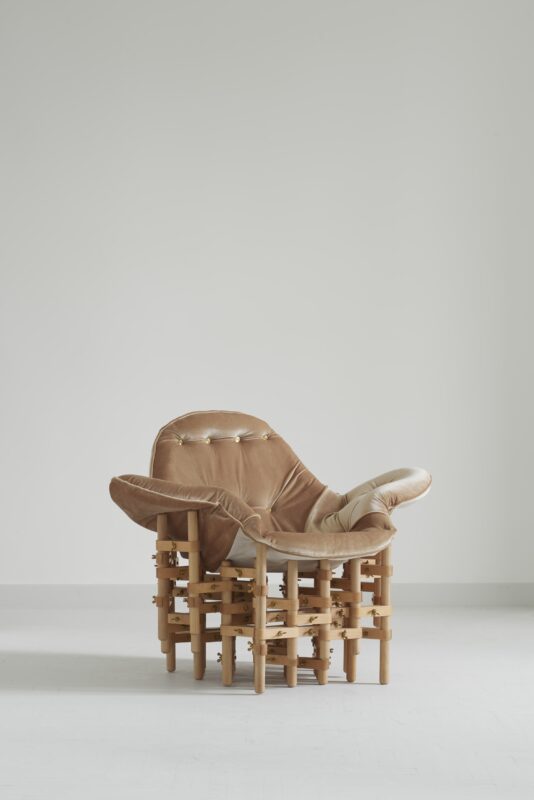LITHUANIAN DESIGN PRESENTED IN LONDON: THE RACE WITH NATURE HAS BEEN WON!

Lithuanian conceptual design will be among the presentations within this year’s London Design Festival (12–20 September), showcased as part of the international design exhibition Virtual Design Destination in the form of a collection curated by Audronė Drungilaitė and presenting works by Agnė Kučerenkaitė, Barbora Žilinskaitė, Evelina Kudabaitė, Etc.Etc. Studio (Inesa Malafej and Arūnas Sukarevičius), Marija Puipaitė and Vytautas Gečas, Monika Gedrimaitė and Severija Inčirauskaitė-Kriaunevičienė.
The project is organised by the digital design gallery Adorno in cooperation with the Lithuanian Culture Institute and the Lithuanian Cultural Attaché in the United Kingdom Justė Kostikovaitė. A virtual tour of the Lithuanian collection with a guide will take place on 17 September, at 5 p.m. Lithuanian time.
A race with nature
Apart from Lithuania, the exhibition will feature curated design collections from 13 countries: Belgium, Denmark, Estonia, Finland, Iceland, France, Romania, Latvia, Norway, Poland, Spain, Sweden and the Netherlands. In total, more than 200 designs will be presented.
The Lithuanian design collection Race with Nature reflects the never-ending competition between humans and nature. The scenography of the exhibition conceived by the curator Audronė Drungilaitė tells the history of a unique landscape as four villages and two cemeteries were swallowed by the shifting sands on the Curonian Spit between 1675-1854. The dune landscape constantly incorporates and transforms design objects that symbolise the urbanised world. The aesthetic juxtaposition of contradictory phenomena allows observers to witness social complications, to observe how a material object can insert itself into the natural environment.
The virtual gallery ADORNO has always strived to apply the latest technology. In early 2020, the gallery developed a three-dimensional object scanning app that helps designers easily and quickly digitise works using a mobile phone.
“We can say that we are currently experiencing a real ‘race with nature’ – the new virus is changing reality and usual activities. At the beginning of the quarantine, it seemed that the promotion of professional art abroad, like any aspect of internationality, would suffer the most in cultural life. However, we are seeing more and more examples of how, when one door closes, even more windows open! We are very happy that the wonderful Lithuanian designers have a virtual but very real opportunity to participate in the London Design Festival. In this instance, I believe we’ve won the race!”, says Aušrinė Žilinskienė, Director of the Lithuanian Culture Institute.
Audronė Drungilaitė, the curator of the collection of works by Lithuanian designers, shares her thoughts: “To be honest, I was a bit sceptical about virtual exhibitions until now – they often lack interactivity, objects are not reproduced realistically and the connection with the creators is lost. The ADORNO virtual gallery first caught my eye with its high aesthetic level of work. The concept of the virtual exhibition New Reality is truly relevant, the organisers took excellent care of crucial components to help them realise their vision: internationally acclaimed curators, unique scenography, limited edition design objects, video interviews with designers and prestigious media channels. This project is evidently programmed for success!”, says the curator.
According to Martin Clausen, the creator and creative director of the ADORNO initiative, the COVID-19 pandemic has led to the cancellation of physical exhibitions, which has further increased the need for digitisation. “Despite the difficult circumstances, with the help of partners, we managed to realise our old dream – to invite ADORNO followers to a virtual exhibition. The Lithuanian collection charms with its sincerity, awareness and mastery. In the presented works, art and design are strongly connected. The biggest discovery for me are the works of Vytautas Gečas and Marija Puipaitė, which are a perfect example of a synthesis of functionality and unexpected aesthetics,” says Clausen.
About the exhibits
The “Naïve” chair by designers Arūnas Sukarevičius and Inesa Malafej reflects the e-commerce boom that intensified during the days of the pandemic. This chair is easy to disassemble and fits in a pizza-sized box, making it extremely easy to transport.
The collection “Envisioned Comfort” created by Marija Puipaitė and Vytautas Gečas echoes the shapes of the human body and creates the impression of imaginary comfort, associated with a comfortable everyday life – luxury, refined taste and cleanliness. Such comfort is the opposite of a natural environment, the charm of which lies in imperfection, naturalness and dirt.
The plaster used in the mirror and candlesticks “Raitūzai” is an element of classic interior decor with natural motifs which contrasts with precisely cut mirrors and metal.
Barbora Žilinskaitė’s “Sunday Light Mirror” reflects the environment, mimics daylight and artificially creates “sun rabbits”, moving spots of reflected sunlight. This object perfectly relates to the theme of “New Reality”, as it emphasises man’s eternal desire to tame nature. Another object by the same designer is the conceptual vase “Afterwards” is a ritual created by the author, which encourages to pursue one’s goals by playing with a piece of nature – a plant. Each stone that is thrown in symbolises the achievement of the set goal, and each time the goal is reached, the thrown stone raises the water level, thus keeping the plant alive.
The “Ignorance is Bliss” collection of glaze-covered porcelain tableware created from waste from the metal industry is like a silent apology to nature in an attempt to compensate for the damage caused by human economic activity.
Severija Inčirauskaitė-Kriaunevičienė’s carpets “Repeated” symbolise collective memory, life stories of different people, which are united in one object. The embroidered bucket lamp is a great example of a nature-inspired craft.
Monika Gedrimaitė’s rough-surfaced vase is a unique example of natural and unconventional beauty, which is rarely found in a polished urban environment.